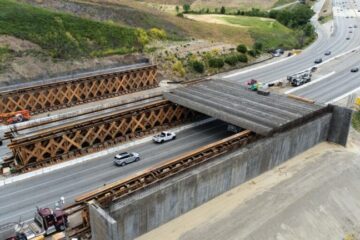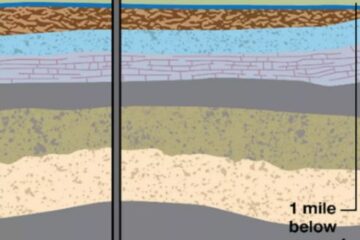President Bush repeals a rule protecting millions of acres of forest
Winding Paths for Roadless Lands – Bush’s push to repeal a Clinton rule protecting 58.5 million acres of forest underlines the differing views of the two administrations.
Source of this article – Los Angeles Times, July 26, 2004.
By BETTINA BOXALL, Times Staff Writer

WILD FOREST: Tim Allyn, left, of the Sierra Club and environmental activist Alasdair Coyne of Ojai stand above the Cuyama Valley in the Los Padres National Forest. The forest is protected under a Clinton-era rule banning road building and timber cutting.
On the shoulder of Southern California, the nation’s capital of freeway sprawl, there is still country virtually as roadless, raw and unpeopled as ever.
More than half a million acres are in the Los Padres National Forest, where the terrain, steep and folded like a compressed accordion, is home to the endangered California condor, provides drinking water for Santa Barbara and acts as a primitive playground for millions of people who jam the urban valleys down the coast.
On the eastern edge of the state in the Inyo National Forest, the nation’s highest desert mountain range looms — an empty place of ancient bristlecone pines, bighorn sheep and windy solitude.
To the north, in the Tahoe National Forest, old-growth sugar pines and incense cedars tower in backcountry that has never heard the buzz of a chain saw or the roar of an SUV.
Those places are among 58.5 million acres of national forest protected under a Clinton administration rule that banned road building and commercial logging.
Almost all the wild lands are in Alaska or 11 other Western states, including 4.4 million acres in California.
The most sweeping conservation move of the Clinton presidency, the bans were both applauded and attacked for placing 31% of the national forest system off limits to timber cutting and to the creation of new roads.
Two weeks ago the Bush administration made its own move — proposing to drop the Clinton prohibitions and instead give state governors a considerable say in whether the areas are protected.
The proposal is the latest in a series of administration actions that are reshaping management of the West’s vast public lands, rolling back not only Clinton-era conservation policies but some that date from the Ford and Reagan years.
Underlying the push for reversal is a battle that has raged for decades over the purpose of the 192 million acres of national forest.
Are the forests for logging, mining and energy production? Recreation? Protection of water and wildlife? The laws governing the forests say they should be used for all those purposes, leaving the task of finding a balance to the U.S. Forest Service and federal officials.
But priorities shift from administration to administration, perhaps never so dramatically as in the last dozen years.
When Clinton’s roadless edict was issued in January 2001, Mike Dombeck, then chief of the Forest Service, called protecting some of the nation’s last wild and unfragmented territory an intrinsically American thing to do. “Europe has its great castles and works of art,” he said. “Africa has its ancient pyramids and cultures. Here in America, we have our wild places.”
The language of the rule offered more pragmatic justifications. Roadless acreage is a source of clean drinking water for millions of people and functions as a biological stronghold for plants and wildlife. The forest system is already crisscrossed by 386,000 miles of road the government can’t afford to maintain.
But in some quarters the roadless rule looked like a sneaky way to circumvent Congress and create what amounted to new wilderness.
By placing so much of the national forests out of bounds to industrial activity, “the roadless rule changed the mission of the Forest Service,” contended Michael Klein, a spokesman for the American Forest & Paper Assn., which filed one of nine lawsuits challenging the bans on road building and timber cutting.
“If you want to change the national forest system to the national park system, let’s have a debate about it,” Klein added. “Instead it was tied up in this rhetoric, ‘it’s the last pristine wilderness.’ And it’s not true.”
At a recent Boise, Idaho, news conference, U.S. Agriculture Secretary Ann Veneman announced a proposed rule that would revoke the roadless protections. In their place, state governors would have 18 months to petition her office to maintain road and timber cutting prohibitions — or open the holdings to more development. The final decision would be up to Veneman.
If a governor doesn’t file a petition, the roadless land in that state would be managed according to individual national forest plans that governed the areas prior to the Clinton decree. According to the Forest Service, those plans would allow activities involving road construction on about 34 million of the 58.5 million acres.
In California, the Forest Service says it has no intention of a road-building spree. “It would take a very compelling reason under any future scenario for us to undertake any large-scale road building in inventoried roadless areas,” regional spokesman Matt Mathes said.
“That may be [its policy] this month or this week,” retorted Jay Watson of the Wilderness Society. “But I’ve been here 20 years with the Wilderness Society and I’ve seen any number of roadless areas proposed for logging, for brand new ski areas. We’ve got 11 roadless areas on the Los Padres under study for oil and gas.”
Of the 140,000 acres of the Los Padres believed to have high potential for gas or oil reserves, three-fourths of them are roadless, according to the Forest Service. Over the years, two ski areas have been proposed for roadless land in the eastern Sierra. There are longstanding mining claims, never developed, in the White Mountains north of Death Valley.
The Bush proposal, Watson said, would kill a policy developed with extensive public participation. “It was a wide-open, drawn-out process addressing some of the most important components of the national forest system. Roads aren’t in short supply,” he said. “There are literally enough roads in the [U.S. forest] system to go to the moon and halfway back. The diminishing asset is roadless areas.”
Agriculture Undersecretary Mark E. Rey, who oversees the Forest Service, said the decades-long debate over roadless forest land clearly had not been resolved by the Clinton rule. The new proposal, he said, has a better chance of achieving a consensus. “I think this is a case where we work with governors for mutual agreement.”
But some worry the proposal would give states unprecedented influence in managing national forests. “It strikes me in a sense as an abdication of the federal government’s own obligation,” said Sean Hecht, executive director of the UCLA Environmental Law Center. “Historically and legally, states have an interest distinct from the federal.”
Conservationists maintain that the proposed roadless repeal fits into a Bush administration pattern of using its rule-making powers to open public land to more development.
“It’s largely about removing any roadblocks that may have been erected in the last couple of decades to oil and gas development, timber harvesting, hard-rock mining and water privateers,” said Simeon Herskovits, an attorney with the Western Environmental Law Center, a public interest law group.
Environmentalists cite a number of actions the administration has taken. The U.S. Bureau of Land Management, which oversees more acreage than the Forest Service, has dropped a 28-year-long practice of surveying potential wilderness areas, effectively capping the amount of its land that can gain formal wilderness protection.
The Forest Service in California curtailed Clinton-era protections for Sierra Nevada forests, and in the Pacific Northwest amended a forest plan to eliminate wildlife survey requirements that had hindered logging stands of old trees.
Under a proposed change to a forest-planning rule, federal managers
would no longer have to conduct public environmental reviews when they update forest land-use plans. The revisions would also weaken a Reagan-era provision that national forests be managed to maintain viable populations of wildlife species.
Administration officials say they are simply trying to loosen the stranglehold of bureaucratic requirements that they maintain have trapped federal land managers in a cycle of paperwork, planning and litigation, preventing them from doing their jobs of taking care of public lands.
“Any of those functions we can get done better, faster and cheaper is the mantra we’ve been using,” said Rey, a former timber industry lobbyist who frequently cites a report from 2001 that 40% of the U.S. Forest Service’s funding was eaten up by bureaucratic procedures and paperwork.
Rey disputed the contention that the administration is employing its rule-making powers to reinvent decades of public lands policy. “I’m not interested in taking us back to any point in the past,” he said. “I’m interested in what is the best approach for the future. I’m not interested in eliminating or reducing citizen participation.”
Oregon State University forestry professor Norman Johnson, who chaired a scientific panel that advised the Clinton administration, says he disagrees with some of the changes Bush officials are making but doubts they will unleash a logging frenzy. There aren’t enough saw mills, nor is there enough demand for domestic wood or sufficient public backing for that to occur, Johnson said. “I really believe there is relatively little danger of massive exploitation.”
Bush officials aren’t the first to use rules and regulations. The Clinton administration was also adept at making broad-ranging regulatory change. Along with the roadless rule, for example, Clinton used his executive powers to create a number of national monuments, which angered officials in several Western states. In a move put on hold by the Bush administration, Clinton officials also rewrote the forest planning rules so that they emphasize ecological sustainability.
“For better or worse, these kinds of administrative rulings have become a way to bypass the gridlock in the legislative process,” said Terry L. Anderson, executive director of the Montana-based Property and Environment Research Center. “We have seen the two-party system create a pendulum that swings back and forth on environmental policy.”
Still, Jerry Franklin, a University of Washington professor of ecosystem analysis whose work influenced Clinton-era protections for old-growth trees, sees more than a pendulum swing.
“I think this administration is being much more creative in pursuing its objectives than I’ve seen recently in terms of taking things in a totally different direction than has ever been taken before,” he said. “They really do want to make a paradigm shift.”


